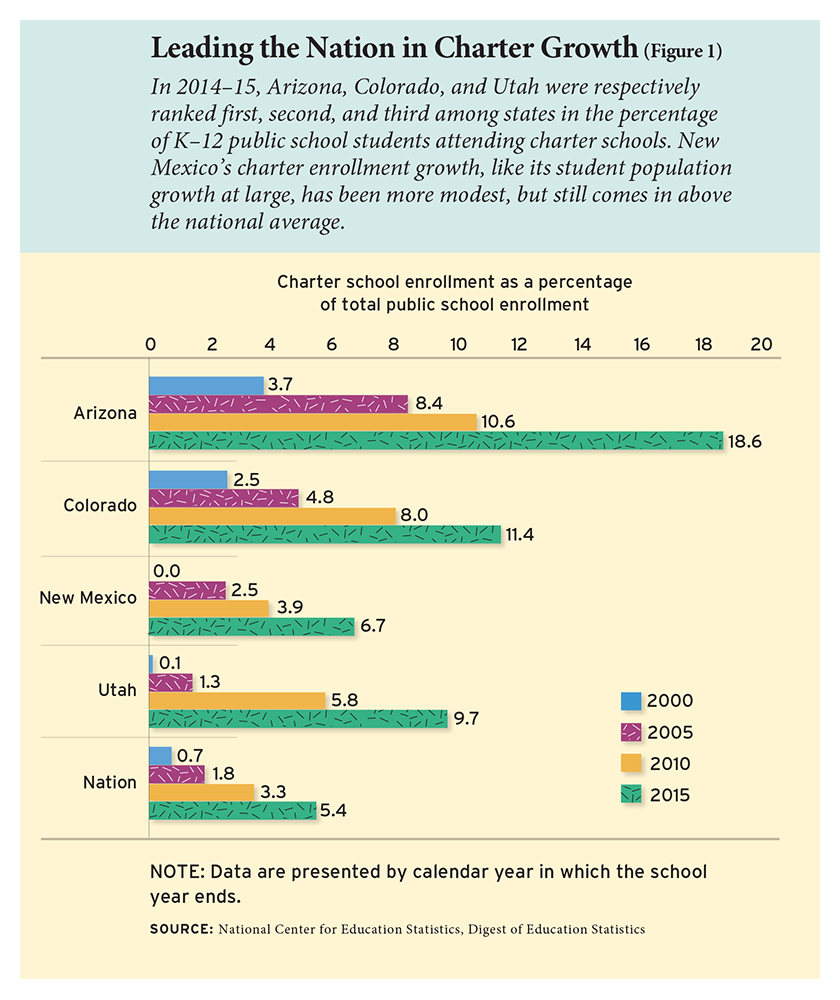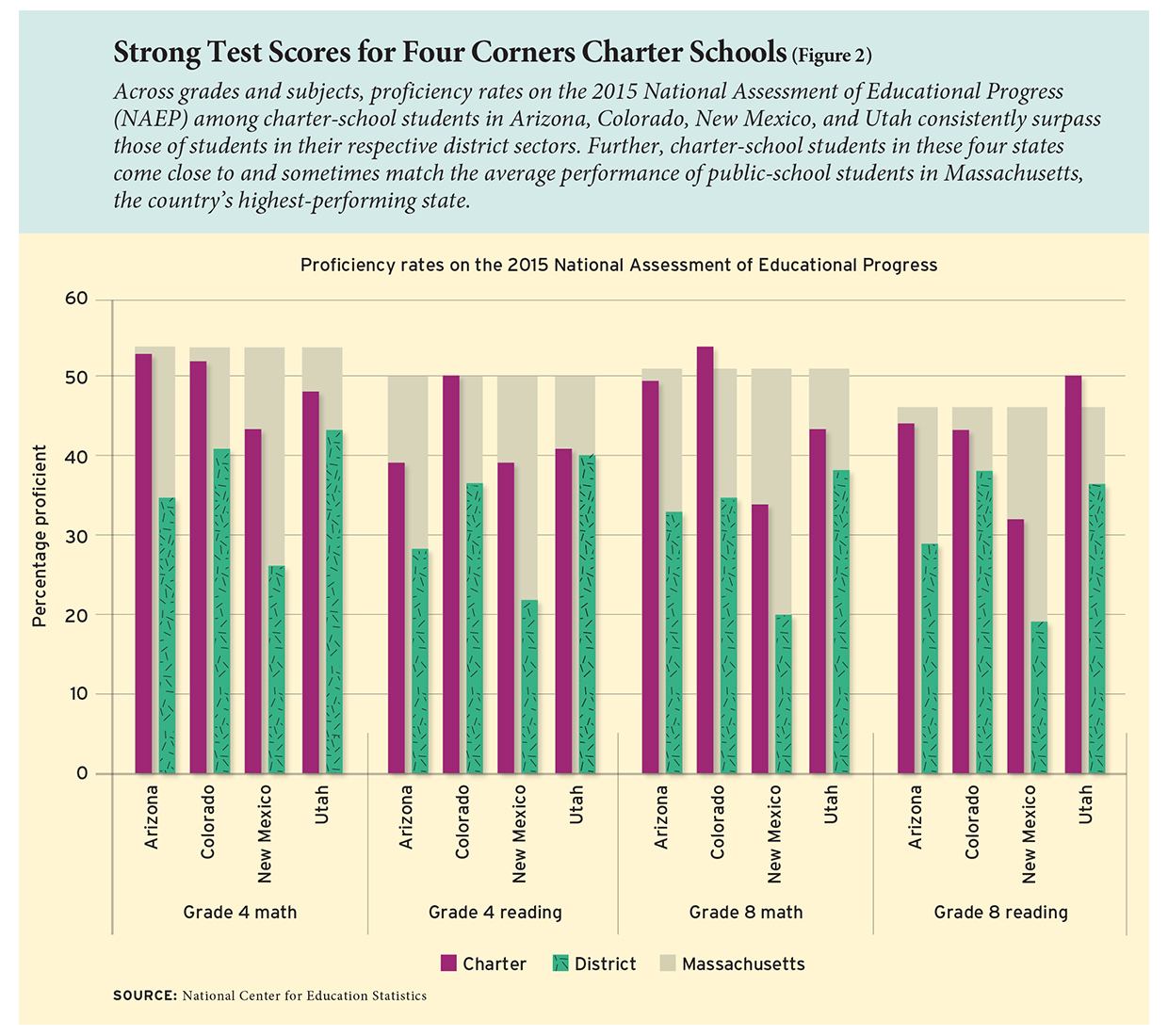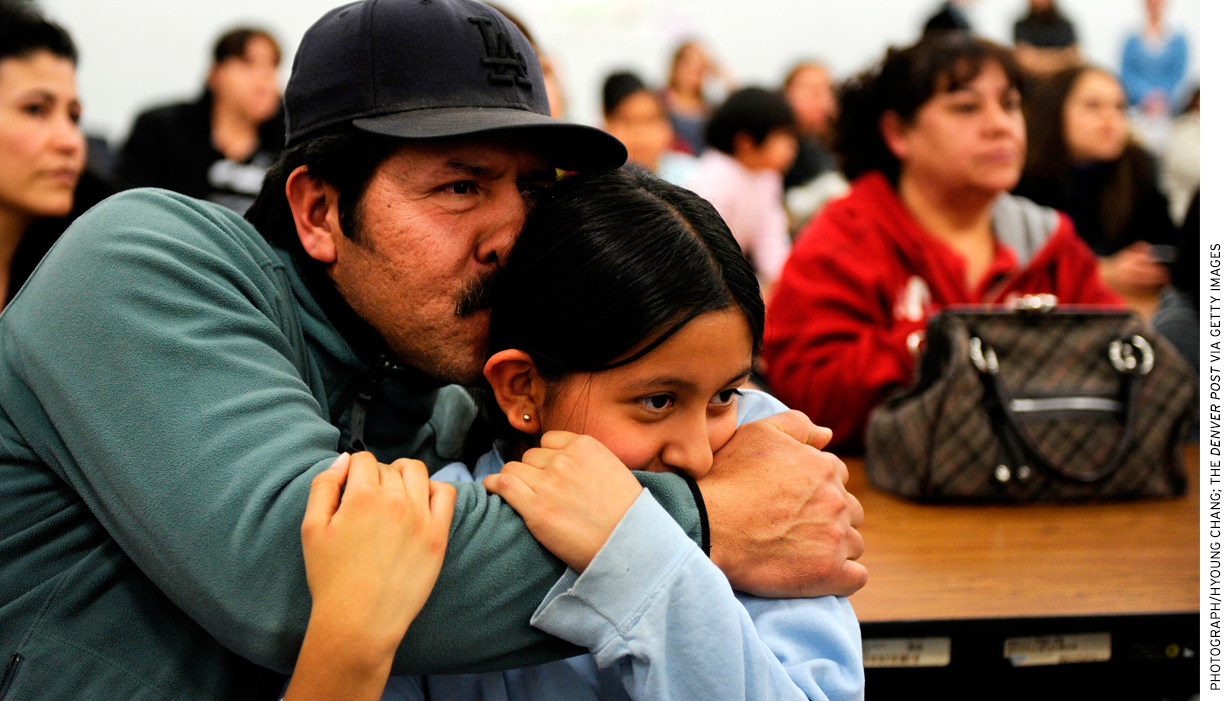
The Senate confirmation of Betsy DeVos as the U.S. secretary of education saw critics hurl accusations that the charter school sector in her home state of Michigan was a “Wild West” of low student performance and authorizing chaos. These charges seemed odd, given that the best studies available on the subject—from Stanford University’s Center for Research on Education Outcomes (CREDO)—show that Michigan charter students make large academic gains relative to similar students at district schools, particularly in Detroit. The use of “Wild West” to describe Michigan seemed odder still to those of us who live in the actual West, especially those of us who pay attention to charter school results. Many of us are happy to embrace the “Wild West” label as it pertains to charter schooling.
Four Corners Charter Policies
The point at which the corners of Arizona, Colorado, New Mexico, and Utah meet is the only spot in the United States where the borders of four states converge. Beyond geography, the Four Corners states share a similar approach to charter schooling. All four states have adopted relatively freewheeling authorization policies, and charter schools there show signs of prospering—and delivering substantial benefits to students.
National organizations that rank charter-school laws have varying opinions on the charter laws of the Four Corners states. The Center for Education Reform gives the Arizona law an A, Colorado’s a B, and both New Mexico’s and Utah’s a C. The National Alliance for Public Charter Schools ranks Arizona 11th, Colorado 5th, New Mexico 22nd, and Utah 23rd among the states in terms of how their laws stack up against the alliance’s “model” state charter law. In essence, these two organizations differ on whether Arizona or Colorado ranks higher, but they both place New Mexico and Utah in the middle of the pack nationally.
A third organization, the National Association of Charter School Authorizers (NACSA), gives low marks to the laws of all four states. In 2014, for instance, NACSA rated New Mexico’s law highest of the four but still gave that state’s law just 14 points out of a possible 30. Arizona and Colorado were a step down from there, earning only 9 points. Utah’s charter law received one of the lowest NACSA scores in the country, at just 8 points. NACSA’s rating system places a higher weight on regulatory features of charter school laws than either the Center for Education Reform or the National Alliance rankings.
The Four Corners states had consistent failings in the eyes of the NACSA raters: None of the states’ laws had a renewal standard tied to academic performance or a default closure provision, under which a school would lose its charter “by default” if it did not meet a minimum standard of performance. Arizona, Colorado, and Utah also did not perform evaluations of authorizers, another part of NACSA’s recommended policy framework. New Mexico’s efforts in this area boosted its NACSA scores above those of its neighbors. (Arizona has since required that authorizers submit annual reports to the state’s auditor general, earning it additional points from NACSA, but the change is too recent to have influenced its charter sector’s results yet.)
Not everyone, however, would hold that the absence of such regulatory policies is a detriment.
Growing K–12 Enrollment
A permissive approach to charter schooling suits the needs of rapidly growing states. Between 1990 and 2014, K–12 student enrollment increased by 22 percent nationwide. In Arizona, the increase was 74 percent; in Colorado, 55 percent; in New Mexico, 13 percent; and in Utah, 42 percent. The limits on charter schools in each of the four states correlate strongly with enrollment pressure—how fast the K–12 market is growing. Neither Arizona nor Colorado, which are both experiencing explosive increases in the student population, has any sort of cap on charters. Facing somewhat lower growth pressures, Utah’s law limits the number of new charter-school students and gives priority to new charters in high-growth areas. In 2015, Utah’s enrollment cap allowed for a 13 percent increase in charter school enrollment. New Mexico limits the number of new charter schools to 15 per year and 75 per five-year period, with unused spots rolling into an expanded future cap.
Strong overall enrollment growth also tends to engender relatively liberal regulatory practices toward charter schooling. While still prevalent in the West, permissive laws have become rarer around the country. Nationally, charter school growth has slowed in recent years. Robin Lake from the Center on Reinventing Public Education cites high legal barriers to entry, high startup costs, and the challenges of obtaining funding among the possible factors that are at play in this trend.
 “Gone are the days when a couple of successful teachers like Mike Feinberg and Dave Levin, the founders of KIPP, could get a charter on their own,” Lake wrote in The 74. “By some estimates, it now can cost half a million to a million dollars to open a charter school. Startup funds are available, but federal and private funding is increasingly targeted to CMOs [charter management organizations] with a proven track record.”
“Gone are the days when a couple of successful teachers like Mike Feinberg and Dave Levin, the founders of KIPP, could get a charter on their own,” Lake wrote in The 74. “By some estimates, it now can cost half a million to a million dollars to open a charter school. Startup funds are available, but federal and private funding is increasingly targeted to CMOs [charter management organizations] with a proven track record.”
The Four Corners states have seen rapid charter growth and even more-rapid growth in demand since the turn of this century. All four have experienced charter-school enrollment growth above the national average (Figure 1). In 2014–15, Arizona, Colorado, and Utah were respectively ranked first, second, and third among states in the percentage of K–12 public school students attending charter schools. Arizona had as many as 619 charters as of 2014–15, trailing only California in absolute numbers, yet the net impact of this growth was merely to slow the rate of enrollment growth within school districts—at least until the advent of the Great Recession, which (temporarily) moderated statewide population growth. New Mexico’s charter enrollment growth, like the growth of its student population at large, has been more modest, but it is still above the national average.
This relatively rapid pace of charter growth in the Four Corners states, however, has not been enough to satisfy demand. In 2010, the Colorado Department of Education estimated that charter schools statewide had 38,000 waitlisted applications—including 7,500 at a single school. In Arizona, the Great Hearts charter-school network reports 20,000 students on their waiting lists. “We have more students on our wait list than we do in our schools,” Great Hearts cofounder Dan Scoggin reported to the Phoenix Business Journal. “We could open another Great Hearts right away if we had the funding.”
In Utah, charter schools have experienced similar success. “The explosive growth in the number of charter schools has been just wonderful,” Royce Van Tassell, executive director of the Utah Association of Public Charter Schools, told the Deseret News. “If you look back over the past decade, I think charter schools have absorbed half of the growth in the number of students in Utah public schools. And there are literally thousands more on the waiting list hoping to [make] that same choice.”
In 2017, the New Mexico Public Education Department responded to a legislative proposal to implement a charter school moratorium by noting, “The families of New Mexico continue to seek alternative, quality choices for the education of their children. The best charter schools throughout the state have unbelievably long waitlists. By enacting a charter moratorium, this bill would deny the families of New Mexico the opportunity to make the best choices for their students’ education.” The measure did not survive.
Naturally, parents are most interested in finding the best schools for their own children; they have less incentive to care about the overall performance of an entire system of schools. But that performance is the rightful concern of policymakers. Further growth of charter schools in these states would serve both individual families and the greater population, because it would address unmet family demand and numerous studies indicate that parental choice has, if anything, a positive impact on district performance.
Where Charter Schools Locate
In general, charter schools tend to concentrate in cities. The National Alliance for Public Charter Schools reports that, nationwide, 55.6 percent of charter schools operate in urban areas, as compared to only 24.5 percent of district schools.
Conversely, charter schools are underrepresented in suburbs, towns, and rural areas, and their sparse presence there poses political barriers to those who would hope to develop a strong and diverse advocacy coalition for charter schools. As Rick Hess of the American Enterprise Institute has pointed out, the education-reform movement’s “achievement gap mania” does little to enlist the support of the affluent parents who largely populate these areas. “Because middle-class parents and suburbanites have no personal stake in the gap-closing enterprise, reforms are tolerated [by them] rather than embraced,” Hess wrote in 2011.
The 2016 Massachusetts charter-school ballot initiative illustrated the reality of this dilemma. In that election, voters decisively rejected a statewide measure that would have raised a cap on the number of charter schools that was binding only in the state’s urban centers. Afterward, some charter advocates expressed concern that suburban voters might view charter schools as something that they pay for through their taxes but which does not benefit their communities. Derrell Bradford, executive director of the New York Campaign for Achievement Now, asserted that the failure of the Massachusetts initiative indicated a need for a “suburban strategy” for the charter school movement.
Relatively liberal charter laws in the Four Corners states have produced a broader distribution of charter schools there relative to the nation as a whole. Charter schools in all four states are concentrated in urban areas, but to a lesser degree than in the nation as a whole. In Arizona—a highly urbanized state with population primarily clustered in the Phoenix and Tucson metropolitan areas—both charter and district schools are concentrated in urban areas, yet as of 2010 there were more than 200 charter schools operating in suburbs, towns, and rural areas. Colorado had more than 100 charter schools operating in non-urban communities that same year.
Utah’s focus on relieving district growing pains by focusing new charters in high-growth areas has led to charter schools being underrepresented in towns but overrepresented in rural areas.
New Mexico’s charter cap shields small districts from enrollment loss, and as a result, the state’s charters cluster primarily in urban settings (51 percent of charter schools operate there compared to 21 percent of New Mexico’s district schools) and in suburbs (which host 12.3 percent of the state’s charters but only 8.2 percent of its district schools).
An analysis of transfer transcripts performed by the Scottsdale (Arizona) Unified School District reveals an often overlooked benefit to inclusive choice policies: they incentivize suburban districts to participate in voluntary open enrollment (the practice of allowing students who live in one school district to apply to attend school in another). Scottsdale Unified, a wealthy suburban district, hired a team of demographers to study enrollment trends, and in 2012, Arizona’s auditor general released a report on the district. Scottsdale Unified has the capacity to serve 38,000 students but educates only 25,000—4,000 of whom opted for Scottsdale schools through open enrollment. These 4,000 transfer students would have ranked Scottsdale Unified as the ninth-largest charter school management organization in Arizona that year, if indeed it were a CMO.
In many areas of the country, well-to-do suburban districts choose not to participate in open enrollment, but in Arizona almost all districts do. Compare that state’s situation to the one in Ohio. The Fordham Institute released a study of open enrollment in Ohio, documenting that all of the state’s urban centers are surrounded by suburban districts that do not accept open-enrollment students. The fact that 72.6 percent of Ohio’s charter schools operate in urban areas likely has something to do with the fact that the state’s suburbs continue to opt out of enrolling students from other districts.
Refusing such transfers isn’t a practical option for Arizona’s suburban districts; they need the students. Scottsdale Unified’s analysis, for instance, showed that there were 9,000 school-age children living in the district but not attending its schools. The analysis of transcript requests from students exiting Scottsdale schools revealed that a large majority of them were leaving to attend charter schools. Scottsdale Unified was using only 65 percent of building capacity, despite taking in 4,000 out-of-district children. Reflecting a statewide trend for both districts and charters, Scottsdale Unified shows consistent signs of academic improvement on the state’s test, the AzMERIT. Choice programs have put pressure on Scottsdale Unified, and academic results there have improved.

Academic Success
What else, beyond population growth, explains the rapid rise of the charter sector in the Four Corners states? Higher test scores among charter students are probably part of the equation. It is difficult to pin down the relative quality of charter and district schools with confidence without studies that use admissions lotteries to compare the achievement of students who win charter-school admission to those who don’t. Few such studies exist, and indeed this approach is impractical for studying entire sectors of charter schools within a state, not all of which are consistently oversubscribed. The factors explaining the performance of charter school students thus remain a bit of an academic holy mystery—hotly debated, though possibly unable to be resolved for the time being.
While scholars and advocates can and do pore over less-definitive types of evidence, hundreds of thousands of parents make practical schooling decisions based on information they gather through word of mouth, campus visits, and the rankings available on online platforms such as GreatSchools. Several websites provide analysis of raw test scores, and some also collect parental reviews of schools. Research suggests that parents trust nonprofit sources of school data more than state government sources, and that parental reviews have a significant impact on other parents’ impressions of schools.
To the extent, if any, that parents prioritize test scores in their decisionmaking calculus, they are likely to approve of the data from charter schools in Arizona, Colorado, New Mexico, and Utah (Figure 2). Proficiency rates on the 2015 National Assessment of Educational Progress (NAEP) among charter students are not only consistently higher than those of students in their respective district sectors, but many of these rates compare favorably to the states with the highest average levels of performance. Four Corners charter students do well on NAEP, even when compared to public school students in Massachusetts, the highest-performing state. Massachusetts holds its own in these comparisons but doesn’t always win—despite its considerable socioeconomic advantages. On 8th-grade math, for instance, Arizona charter students nearly match the average performance of Massachusetts, while Colorado charter students surpass the average level of proficiency of Bay State students.
Factors other than school quality could help to explain high levels of achievement of charter school students in these states—including the ability of parents to close underperforming schools. In theory, parents will opt to close the lowest-performing charter schools, allowing only the better ones to continue (and eventually report test scores). Long waiting lists for charter seats, however, indicate that many Four Corners parents are finding charters to their liking, whether they are basing their judgments on test scores or any of a host of other factors.

Parent Power
In March 2017, nearly 25 years after the first charter school opened in Colorado, the Denver Post published a retrospective piece on the growth of charters in the state. The story noted that 50 charter schools had closed over that time period, and that this rate was about twice the national average. “Most [schools] shuttered because of enrollment projections that fell short, changes in leadership and lagging test scores,” the article noted. Consistent with Colorado’s low NACSA score, the Post quoted a Colorado superintendent as positing that the state board believes that charters should “rise and fall only on parental choice.”
Alex Medler, a consultant and former NACSA vice president for policy, provided a striking illustration of why Colorado’s sector seems to be flourishing. “Take the roughly 1,700 public schools in Colorado, multiply that by 20 years, and the odds of a district-run public school being shut down by the state is 34,000 to one,” Medler said to the Post. (In other words, the Colorado State Board of Education had shut down only one public school for poor performance over the preceding two decades.) “Compare that to one in 10 charters closing—one in five for Colorado—and you’ll see the imbalance. The lopsidedness of district-run school versus charter public school accountability is striking,” Medler concluded.
In Arizona, parents seem to be even more active in closing undesired charter schools than their Colorado counterparts have been. A nationwide list compiled by the Center for Media and Democracy of charter school closures between 2000 and 2013 included 290 Arizona schools. Also supplied were the year of each school’s closing, enrollment at the school in its final year of operation, and, for 150 of the Arizona schools, the year the school opened. For those 150 schools, the average length of operation was four years. The average enrollment for all 290 closed schools in the final year of operation was 62 students.
By statute, the state of Arizona grants 15-year charters, but a very large majority of closed Arizona charter schools are out of business many years before their charters are scheduled for renewal. The Arizona State Board for Charter Schools does occasionally revoke charters or choose not to renew them. The board listed 13 instances of revocation or non-renewal of charters between 2010 and 2014—a small percentage of the total closures.
Administrative attempts to close charter schools are often met with fierce parental opposition and lawsuits, but when parents don’t like a school, they can simply vote with their feet, either by withdrawing their children from the school or by not choosing it in the first place. It is therefore parents, rather than state officials, who play the primary role in holding Arizona charter schools accountable, in a highly efficient manner. An abundance of K–12 opportunities—including charter schools, district schools, district open enrollment, magnet schools, and private choice programs—gives Arizona parents many exit options. Another key factor contributing to charter school closure may be that Arizona’s suburban districts, unlike those in many other states, are actively involved in accepting open-enrollment transfers.
Opening a charter school in Arizona is not for the faint of heart—if your school lives to see year five, odds are you are doing something right. If one assumes the wisdom of crowds, the Arizona charter sector’s 2015 NAEP performance and its sizable score advantages on the AzMERIT were not surprising. Educators opened a large number of schools, and collectively parents took the lead in deciding which would grow and which would close.
NAEP results also reveal that K–12 education in Arizona is improving overall. NAEP provides statewide data on six subjects (4th- and 8th-grade exams in math, science, and reading). Arizona was the only state whose students made statistically significant gains on all six exams for the entire period for which complete data are available (2009 to 2015). That improvement stands in contrast to that of other states: If one subtracts the number of significant declines in scores from the number of significant increases in the individual states, the average state experienced a statistically significant increase on only one NAEP exam during this period.
Arizona shows signs of a virtuous circle: suburban charters and private choice programs helped to encourage school districts to offer open enrollment. In suburban districts, this open-enrollment policy not only provided the opportunity for outside students to attend these schools, it also increased the competitive pressure on new charter schools.
Learning Together
Just as the country benefits from political diversity, we also benefit from a diversity of policy approaches at the state level. There are those who seek greater uniformity among state charter-school policies—urging that all charters should be for five years and that default closure provisions should be spelled out, among other guidelines. Such advocates should consider the success of these western states, which have chosen not to adopt such policies. The 50 states will become less useful as laboratories of reform if we adopt a single set of policies everywhere.
Many states—including three of the four featured here—have experienced high rates of overall K–12 enrollment growth, which raises the opportunity cost of imposing a stringent charter-authorizing process. It does not follow that every state should rush to amend its charter policies to match those of Arizona, Colorado, New Mexico, or Utah, but the obvious flourishing of the charter sectors there offers food for thought. Questions to consider and debate include: What factors have led to success in these states? What steps can policymakers and philanthropists take to enable parents to take the leading role in closing undesired schools? How important a role does open enrollment in suburban districts play in creating a successful bottom-up accountability system?
We don’t know the answers to these questions. But we do know that relatively freewheeling charter-school systems have prospered in multiple states. Surely we have as much to learn from these success stories as we do from the cautionary tales from states that have experienced difficulties.
Matthew Ladner is a senior research fellow at the Charles Koch Institute.
This article appeared in the Spring 2018 issue of Education Next. Suggested citation format:
Ladner, M. (2018). In Defense of Education’s “Wild West” – Charter schools thrive in the Four Corners states. Education Next, 18(2), 16-23.


